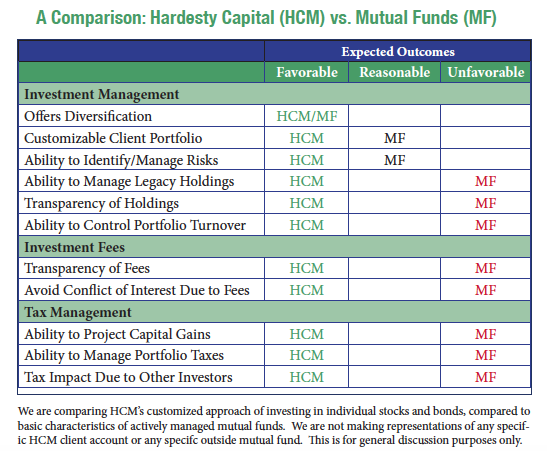Investors Beware: The Pitfalls of Mutual Funds
 Many financial advisors build a book of business using mutual funds for their affluent clients. Is it because funds have favorable characteristics and offer stronger investment returns? Absolutely not – mutual funds have many drawbacks!! First, they limit an advisor’s ability to customize a portfolio and manage risk effectively. Second, they add an additional layer of fees, which reduces an investor’s returns. Third, they are inefficient for investors who want to manage their tax bills. (Please see our Tax Loss Harvesting article on page 5.) Small retail investors have few options and mutual funds may make sense for them. Fortunately, our clients enjoy a customized approach to managing their money. We invest in a diversified portfolio of individual stocks and bonds to meet your goals. Please read on and you will understand why we favor our approach.
Many financial advisors build a book of business using mutual funds for their affluent clients. Is it because funds have favorable characteristics and offer stronger investment returns? Absolutely not – mutual funds have many drawbacks!! First, they limit an advisor’s ability to customize a portfolio and manage risk effectively. Second, they add an additional layer of fees, which reduces an investor’s returns. Third, they are inefficient for investors who want to manage their tax bills. (Please see our Tax Loss Harvesting article on page 5.) Small retail investors have few options and mutual funds may make sense for them. Fortunately, our clients enjoy a customized approach to managing their money. We invest in a diversified portfolio of individual stocks and bonds to meet your goals. Please read on and you will understand why we favor our approach.
Often, advisors put clients into mutual funds because they lack robust in-house research, or it simply frees up the advisors’ time to go find new business. While funds offer investors instant diversification, it’s a one-size-fits-all approach. A fund manager’s objective may be quite different from that of the investor. For example, a manager’s compensation may be linked to outperforming a benchmark with no consideration for the level of risk taken, the amount of taxes passed on to investors, earned income, or growth of income. Also, a fund’s objective can change over time, as can the manager, which leads to greater portfolio turnover. This cycle is bad for the client’s bottom line.
We believe the limited transparency of mutual funds is problematic. Most investors don’t know what stocks they are holding in the fund, and many funds disclose their holdings only semi-annually. An investor may have 50 stocks or more in a single fund. Imagine tracking your portfolio if you own five or ten stock funds – that can add up to 500 or more stocks in your portfolio. Diversification is a good thing, but not so for over-diversification.
Risk management is one of the keys to our process. Our clients can see what they are holding at any time, and we can readily identify a portfolio’s risks and sector positioning. While we are not traders, our disciplined approach allows us to take advantage of intraday volatility in stocks that we want to purchase on weakness or to sell into strength. Also, we can quickly reduce portfolio risk and raise cash for our clients on short notice. This may not appear to be a big advantage, but mutual fund investors can only execute transactions at the fund’s daily closing price at the end of the trading day. An investor is beholden to the fund manager and may miss an opportunity to profit from large intraday price spikes (e.g., selling a stock into strength on buyout chatter). Often a rumor is just that, and the mutual fund investor misses the profit potential.

We have a flexible approach that helps us meet our clients’ needs. For example, a client may want to withdraw $50,000 of cash in six months, and to keep the portfolio fully invested until then. We can simply handle the client’s request by buying a bond that matures in six months. Meanwhile, an advisor that uses bond mutual funds to raise cash will expose an investor to the risk of rising rates. Alternatively, an advisor may be forced to sell an equity fund during a period of declining prices. Neither of these alternatives is ideal.
Over the long term, a majority of actively managed funds fails to match the returns of passive benchmarks. Many funds charge an annual fee of 1% or more. It’s hard for investors to know how much they pay since the fees are embedded within the funds. On top of that, financial advisors typically charge at least 1% for their services, so the all-in cost can exceed 2% each year. High fees can significantly impact results, particularly over long time periods, and especially when the markets are down like this year.
Mutual funds don’t help investors who want to manage their capital gains taxes (and who doesn’t want to do that!). A fund is required to distribute capital gains annually. An investor may get stuck with large capital gains distributions even though he didn’t sell the fund. Why? One reason may be that another investor decided to redeem the fund, and an existing holder (you) got stuck with the tax liability. It’s a structural flaw of mutual funds, and is exacerbated during times of market stress (such as the 2008 financial crisis). Here’s our tax warning to mutual fund investors for 2015: even though your fund may decline in value this year, get ready to pay the tax man. Behold the pitfalls of fund investing.
If you are concerned about your outside mutual funds/accounts, we are happy to perform a complimentary portfolio review.



